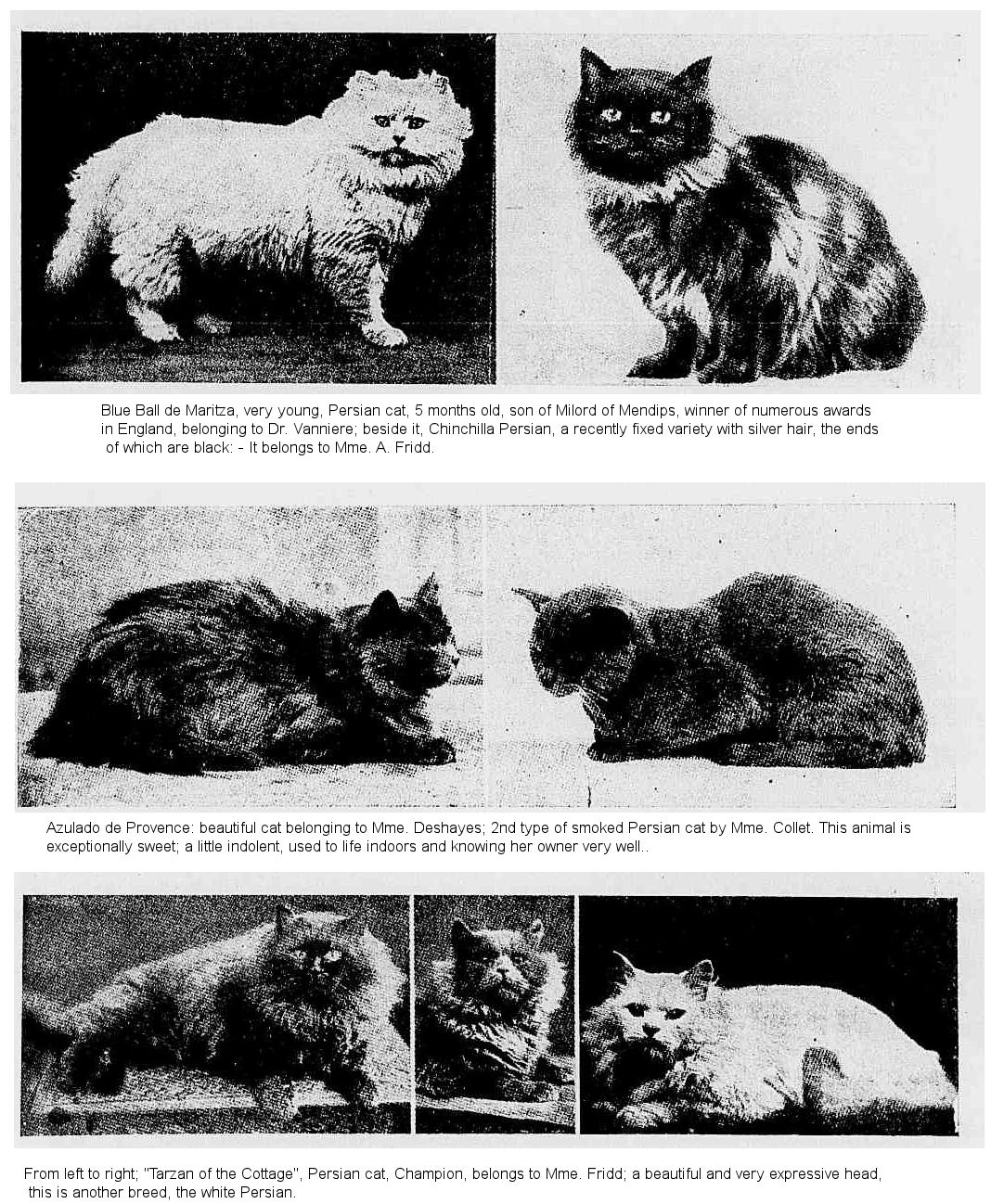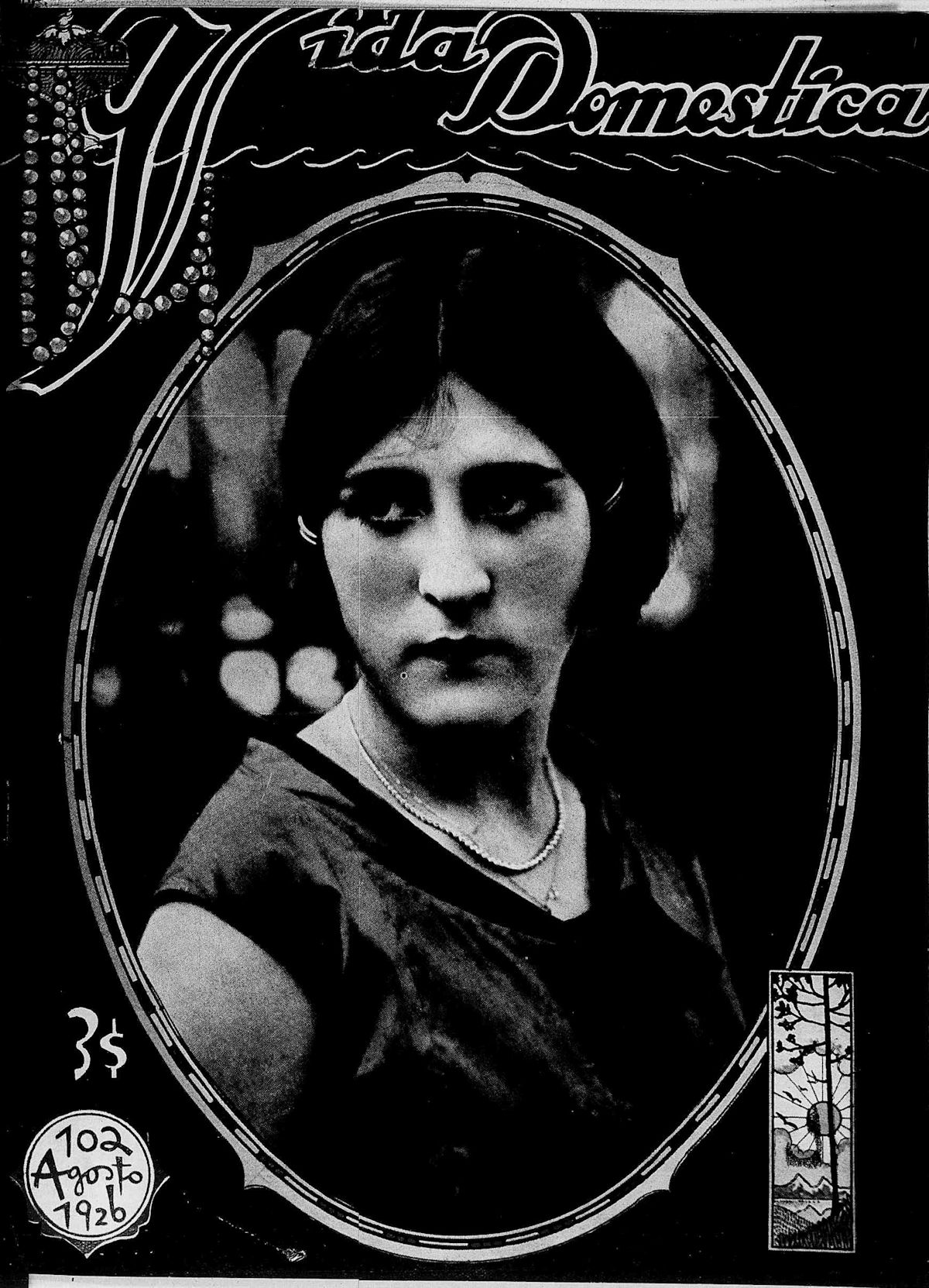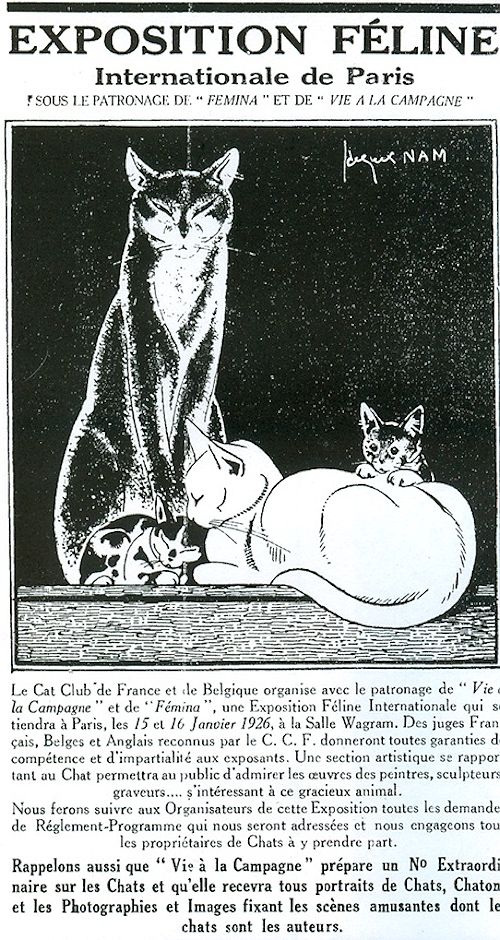The Persian cat with its superb fur, should not be confused with the Angora cat, and is arguably one of the most beautiful felines with numerous fans in England where there is an important trade in this breed. In Belgium there are only a few beautiful specimens, the same being true of France, where this Prince of somnolence and indolence began.
ORIGINS
The Persian cat is originally from Syria, where it still exists, especially the original types: bluish, white and yellowish, characterized by its long, fine hair. This cat is bred on a large scale in England, where it is very fashionable, allowing a series of changes and varieties to be fixed with particular characteristics, colours and patterns, solid colours, cats with more than one colour, and different eye colours etc. For a long time they intended to divide long-haired cats into two classes - Angora and Persian - with the former differing from the latter by various physical characteristics: a more angular forehead, less heavily furred, longer ears, tapering tail, etc. This very artificial classification does not persist and the ordinary Angora is currently considered a degenerate form of the Persian cat.
CURRENT STATE OF THIS BREED
As is the case with most animal breeds, it is the groups, the creation of syndicates, clubs and societies, that allow efforts to be coordinated and unified and guidelines to be codified, setting relatively secure foundations for necessary improvements. In 1887, the National Cat Club was founded in London, and this club organized the first cat shows, becoming more standardised and orderly. The number of animals exhibited at first diminished, but then increased from year to year and were, in turn, more carefully selected. At present, thanks to patient selective breeding, apart from some classes that remain underrepresented due to breeding difficulties, the English-bred solid colour Persian cats have almost reached perfection.
In France, the "Cat-Club" was founded in 1913, but its efforts came to nothing due to the events of 1914 to 1918. After the war, the breeding of Persian cats again become widespread in that country. This animal is starting to be popular, but very beautiful specimens are still very few and far between. The cat shows that are held annually in some cities - Lille, Marseille, Cannes, Angers, etc. - contribute, however, to make them better known. It is therefore probable that, like England, France will very quickly gain the place of honour which it has already won with the pet dog.
The great international cat show of 14 and 15 May last, organized by the "Cat-Club" under the patronage of "Vie á le Campagne” and “Fémina,” in which there were 150 entries, was a great success with great interest shown by the public in the many classified varieties of cats and their breeding processes.

ESSENTIAL CHARACTERISTICS
The ideal type of Persian cat, whatever its colour, has the following physical characters:
General Appearance: - Very robust animal, but with a very elegant shape. Thick, silky fur, more abundant around the neck, over the chest and falling in the shape of a ruff. This contributes to giving the cat a majestic appearance, much appreciated by breeders who assuming that the more imposing the animal is, the more beautiful it is.
Head: -Round and very expressive thanks to its large, very open eyes, which give it a very intelligent look.
Ears: - Small, widely separated, ornamented with a puff of fur arranged like feathers emerging from the inside of the ear.
Muzzle: - Small and thick.
Faces: - Well developed.
Neck fur: - Large, wide, abundant and very long, giving the animal's face a very impressive appearance.
Body and Tail: - The body of the Persian cat is long and flexible. The tail is relatively short with very abundant fur, quite long and arranged regularly, giving the tip a rounded shape.
Legs and Feet: - These are very hairy, short and strongly boned, ending in a big foot tufted with fur.
Coat: - Unfortunately, the coat is lacking for part of the year, so during that period the animal is not always properly appreciated.
DISQUALIFYING POINTS.
Coarse shape.
Head: - long, ending in a snout.
Ears: - very long, not hairy, very close to each other.
Eyes - small and ovate.
Legs: - Very long and very weak.
Feet: - narrow and not hairy.
Tail: - Tapering and with little hair.
Coat: - rough and not abundant.
QUALITIES, DEFECTS, SKILLS, ETC.
The adult Persian cat is a very robust animal. Exceptionally sweet, it rarely scratches and only does so when very irritated by the presence of another cat or a strange person who has frightened it. It knows its owner very well, and always lets itself be held and shows its affection with a thousand caresses. A little indolent, it is very well used to life indoors, but it is not good at hunting mice.
CLASSIFICATION
Persian cats are classified according to their colour, namely: White Persian, Blue Persian, Black Persian, Silver Persian, Chinchilla Persian. Smoke Persian (smoke colour) Amarello Persian (orange); Cream Persian, Brown Tabby Persian (brown striped).
WHITE PERSIAN
The white Persian cat is originally from Asia Minor, where there used to be many, but today it is rare, due to its repeated crossing with foreign animals.
SPECIAL CHARACTERISTICS
Regardless of the characteristics already mentioned above, the white Persian has a snow-white coat and dark blue eyes, its fur being more silky than that of Persian cats of different colours. An attractive animal, in its season of beauty it needs assiduous and daily special care for its fuir to remain beautiful. It is almost completely deaf.
SCALE OF POINTS
Colour 25; coat 25; size and shape, 20; head, 10; eyes, 10; beauty and overall qualities, 10 - Total 100 points.
QUALIFICATION POINTS
Coat: - showing no black hairs, or spots of gingery colour.
Eyes: - very clear, even in those having different colour eyes; one eye, for example, blue and the other green or yellow.
PRINCIPAL CHAMPIONS
French males : Pharmacy of Mayfield, Minley Raseacara, Minley Corning Star; Minley Surprise.
English females : Sensation of Hounslow, Sirmton Heartrease.
BLUE PERSIAN CAT.
The original type once existed in Persia, where it is now very rare. Pietro della Valle, quoted by Buffon, makes the following description:
"There is a species of cats in Persia, originally from the province of Chorazam. The size and shape are those of a common cat; their beauty consists in the colour of their hair, which is grey, and uniformly the same over the whole body, except that it is darker on the back and head, and clearer on the breast and belly, where it approaches to whiteness, say the painters, which is indeed a wonderful effect. Besides, the hair is fine, shining, soft as silk, and so long, that, though not frizzled, it forms ringlets in some parts, and particularly under the throat. These cats are, among all cats, what Barbets are among dogs, being the most beautiful part of the body is the tail, which is very long, and covered with hair five or six fingers in length. They extend and turn it upon their back, like the squirrel, the point resembling a plume of feathers. They are very tame; and the Portuguese have brought them from Persia into India. They are very much appreciated. The Portuguese took them from Persia to India ".
The author says he has four cats that he plans to take to Italy.
ESSENTIAL FEATURES
The blue Persian cat is a beautiful bluish colour, of variable hue, in all shades of blue. However, its creators prefer the lighter tones, except for lavender blue. It is, however, very difficult to preserve this colour in subsequent generations.
In the first breeding attempts, green-eyed cats were admitted to the cat shows. Orange eyes, much more beautiful, were later demanded and at present there are no longer any Persian cats worthy of the name that do not have yellow eyes at least.
STANDARD – SCALE OF POINTS
Coat: - all shades of blue are accepted, without marks, spots or white undercoat.
Long hair, thick and firm to touch. Well developed fur collar, 30 points.
Head: - Large and round with a large space between the ears. Short face and muzzle.
Ears: - small and full of hair, 25 points.
Eyes: - orange, large and round, 20 points.
Body: - thick and short and with low legs, 15 points.
Tail: - short, very hairy, ending in a point, - 10.
Total, 100 points.
DISQUALIFYING POINTS
Fur: - not homogeneous – darker on the back than on the flanks and feet. White hairs or marks.
Shadows: - shadowy markings in the fur.
Eyes: - tending towards green tone.
PRINCIPAL CHAMPIONS
Males, English: Azure of Hadley, Blue Jochett, Neilla Billie of Thorpe, Sir Archie of Arandale.
Females, French: Shamrock, Misty Morning, Regina of Emberton.
The other breeds of Persian cats are more common, but the white and the blue are the most rare and valuable.
CARE OF ADULTS
Adult cats should be fed three times a day. It is necessary to pay utmost attention to the quality of the food, this being the cause of the most frequent disease of the cat: enteritis. It is advisable to vary the diet, alternating the provision of raw meat with that of cooked meat, adding a little pasta, rice or vegetables. Fish is also a good food and should preferably be boiled.
Milk is not recommended as it causes enteritis, but exceptionally, in case of constipation, it should be given, although the usual drink should be pure water.
Grass is essential to its health.
To avoid any deterioration, it is advisable to treat the cat's hair as you would usually treat a horse’s coat. Comb them daily, brush and clean them from time to time with dry shampoo.
CLUBS
The main cat clubs are:
In England: the National Cat Club, founded in 1887, the Northern Counties Cat Club, founded in 1900; the Persian Smoke and Silver Club, founded in 1900; the Blue Persian Club, founded in 1901; the Orange, Fawn, Cream and Tortoiseshell Persian Club, founded in 1900; the Black and White Persian Club, founded in 1900.
In France: - the Blue Persian Club, attached to the "Cat Club de France".
Mme. L. Brassant.

